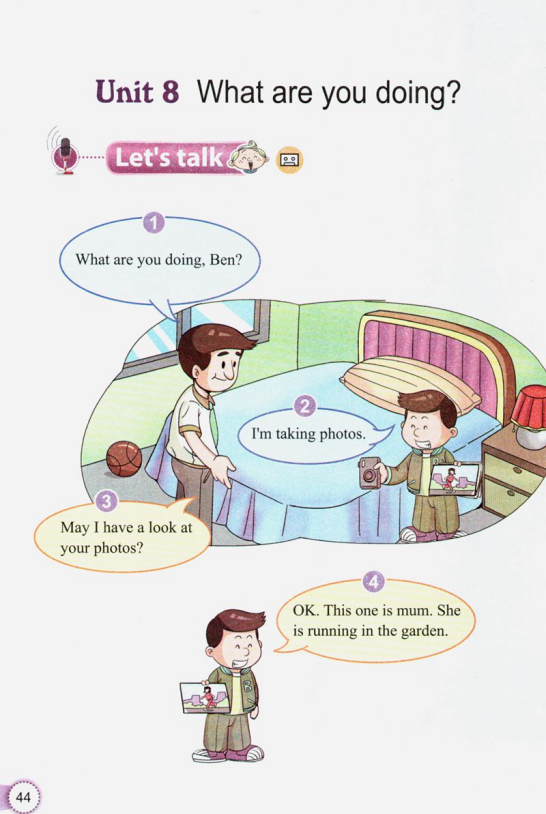关键词: 教师资格证 2022

扫码添加专属备考顾问
▪ 0元领取考点真题礼包
▪ 获取1对1备考指导
一、单选题
1.“劳心者治人,劳力者治于人”的中国传统儒家思想,其错误之处是把( )相隔离。
A.教育与文化
B.教育与经济
C.教育与政治
D.教育与生产劳动
2.古代斯巴达的教育目的是培养( )
A.商人
B.政治家
C.军人
D.官吏
3.“纸上得来终觉浅,绝知此事要躬行。”从教学过程的角度来看,这句话反映了( )
A.掌握知识与发展智力的关系
B.掌握知识和思想教育的关系
C.智力活动与非智力活动的关系
D.直接经验和间接经验的关系
4.小亮同学因为乐于帮助他人而获得了“校德育标兵”的称号,之后班里就形成了一股助人为乐的班风。这种强化属于( )
A.直接强化
B.自我强化
C.替代强化
D.行为强化
5.教师通过清楚而细致地演算例题来帮助学生形成智力技能的阶段属于( )
A.原型定向
B.原型模仿
C.原型操作
D.原型内化
二、教学设计题
What are you doing?

(1)请简述小学英语课程基本理念。
(2)如指导小学生学习这节课,试拟定教学目标、教学重点和难点。
(3)依据拟定的教学目标,设计教学过程。
【参考答案解析】
一、单选题
1.D【解析】题干中这句话的意思是:劳心者作为统治阶级,无需从事生产劳动,而劳力者作为被统治阶级,通过生产劳动创造社会财富,供养统治阶级。这体现了教育与生产劳动相分离的观点。
2.C【解析】古代斯巴达教育以军事体育训练和政治道德灌输为主,教育内容单一,教育方法也比较严厉,其教育目的是培养忠于统治阶级的强悍的军人。
3.D【解析】“纸上得来”为间接经验,“躬行”体现的是直接经验,故题干所述反映的是直接经验和间接经验的关系。
4.C【解析】替代强化是指观察者因看到榜样的行为被强化而受到强化。学生们观察到小亮助人的行为受到强化而表现出良好的行为,这种现象属于替代强化。
5.A【解析】原型定向就是了解原型的活动结构,从而使主体明确活动的方向,知道该做哪些动作和怎样去完成这些动作。故题干中教师的做法属于原型定向阶段。
二、教学设计题
(1)《义务教育英语课程标准(2011年版)》(以下简称课程标准)提出了六条课程基本理念:(1)注重素质教育,体现语言学习对学生发展的价值;(2)面向全体学生,关注语言学习者的不同特点和个体差异;(3)整体设计目标,充分考虑语言学习的渐进性和持续性;(4)强调学习过程,重视语言学习的实践性和应用性;(5)优化评价方式,着重评价学生的综合语言运用能力;(6)丰富课程资源,拓展英语学习渠道。
(2)教学目标:
1.Knowledge and Skills
(1)Students understand clearly the meaning of the sentence pattern“What are you doing?”and can answer it in real life appropriately by using“I am doing……”.
(2)Students correctly transform some verbs that they have learned into their v. -ing forms.
2.Process and Methods
(1)Students use inductive method to conclude the rules of transforming verb into v. -ing after observing several sentences.
(2)Students use the present progressive to do tasks independently or corporately.
3.Emotional Attitudes and Values
Students actively take part in the learning activities and confidently finish the tasks.
教学重难点:
1.Key Points
(1)Students understand clearly the meaning of the sentence pattern“What are you doing?”and can use the sentence in real life appropriately.
(2)Students transform some verbs that they have learned into their v. -ing forms correctly.
2.Difficult Points
(1)Students can pronounce the v. -ing form correctly.
(2)Students understand the present progressive and know how and when to use it.
(3)教学过程:
Step 1 Warm-up
Game:TPR
T:Hello,boys and girls. Let’s start our class. We’ve learned many verb phrases. Now I will say some verb phrases,and you should act them out,ok?I need some students come here and the rest of you do it next to your seats. Any volunteers?
(The teacher writes down the verb phrases on the blackboard while students act them out correctly,such as play ping-pong,draw a picture,read a book,answer the phone,shake hands,etc.)
(Justification:Through TPR,students review what they have learned and prepare for the new lesson.)
Step 2 Presentation
T:Boys and girls. Here’s a ping-pong ball. Do you like playing ping-pong?
Please look at me. What am I doing now?You can ask me“What are you doing?”Ask me together.
Ss:What are you doing?
T:I am playing ping-pong.(Write on the blackboard“What are you doing?—playing ping-pong”)Say“I am playing ping-pong.”
Ss:I am playing ping-pong.
T:What are you doing?
Ss:I am playing ping-pong.
T:Good job.(While drawing a picture on the blackboard)What am I doing now?
Ss:What are you doing?
T:I am drawing a picture.(Write on the blackboard“drawing a picture”)
Ss:I am drawing a picture.
Students read the v. -ing phrases on the blackboard after the teacher and do it together several times.
(Justification:Through imitation,students perceive the present progressive and the v. -ing form.)
Step 3 Practice
The teacher writes down some verbs and asks students to write down their v. -ing forms.
T:Finish?
Ss:Yes.
T:OK. Let’s do a task. I will ask you“What are you doing?”If I point to“swim”,a student should answer me by the phrase“I am swimming.”Then the student will be a master and asks another student to answer what he has pointed to. Understand?
Ss:Yes.
T:Let’s begin. What are you doing?(Point to“write”)
S1:I am writing. What are you doing?(Point to“sing”)
S2:I am singing.
……
While the game is going on,the teacher writes down the v. -ing forms,and highlights the -ing in each word.
(Justification:The chain game can help students drill the v.-ing and let students use it correctly.)
Step 4 Production
Game:Match
The teacher hands out some cards and on the back of each card there is a verb phrase. Two students will have the same verb phrase. Students should find out their partners by interviewing other students. For example:
A:Hello. What are you doing?
B:Hi. I’m answering the phone. What are you doing?
A:I’m drawing pictures.
B:Oh,we are not partners. See you later.
A:See you. What are you doing,C?
C:I’m drawing pictures. What are you doing?
A:Me,too. I’m drawing pictures.
C:Wow,we are partners.
……
(Justification:Interview tasks can help students improve their speaking and listening skills.)
Step 5 Summary and Homework
Summary:The teacher and the students work together to make a chant about the present progressive.
(Justification:To summarize the class by making a chant that is related to the present progressive is suitable for pupils)
Homework:
Pick up one of the tasks as your homework and do it earnestly.
(1)Draw a picture and depict what the people in the picture are doing.
(2)After school,please give your friend a call in English and talk about what you are doing at home.
(3)Please write a short passage to depict what your parents are doing after dinner.
(Justification:The hierarchical homework not only extends the class task into real life but is good for different students)
Board Plan
What are you doing?
play + -ing→playing playing ping-pong
draw + -ing→drawing drawing pictures
read + -ing→reading reading a book
answer + -ing→answering answering the phone
shake + -ing→shaking shaking hands
swim + -ing→swimming
write + -ing→writing

相关推荐:
手机登录确认
微信扫码下载
微信扫一扫,即可下载